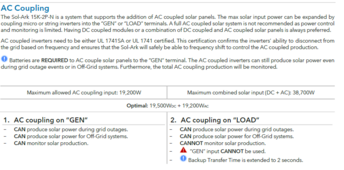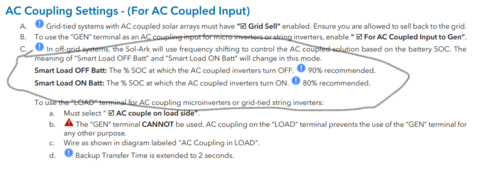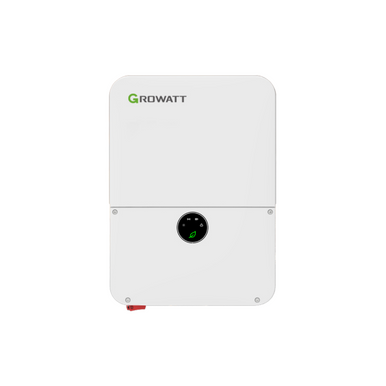Well, I waited a year for a split-phase inverter similar to the EG4 18K, Luxpower 12K, and Sol-Ark 15K that will support 80-400V batteries. It didn't happen, so I'll be pulling the trigger on a 48V system.
I wanted to get some first-hand feedback from those that have AC-coupled their on-grid inverters to any of these inverters. I've confirmed with Sol-Ark that frequency shifting for their systems occurs only on the GEN port, where AC coupling is supposed to take place. The LOAD port, however, does not experience any frequency shifting. Therefore any on-grid inverters tied to a service entrance panel, for example, will not adjust output in the case where the inverter is modulating AC-coupled power. I have 30kWp/24kWi of on-grid inverters, and (1) Sol-Ark 15K is limited to 19.2kW of AC coupling. Short of buying (2) of these inverters, this won't work. Additionally, the Sol-Ark frequency shifting is not pretty - basically on or off - with no gradient. I like Sol-Ark a lot. Their customer/technical support is second to none. But purchasing an extra unneeded inverter at their prices is not an efficient use of capital. Further, at least the Luxpower inverter specifies a gradient frequency shift up to the 62 hz level, versus the sudden shift that Sol-Ark inverters perform.
I cannot find anywhere on what port(s) the EG4 and Luxpower perform their frequency shifting. Since I have my on-grid inverters on the line side of my service entrance, it just needs to see a system-wide frequency shift to adjust power output. So I need the frequency shifting to be on the LOAD port. Does anyone have experience with this and can confirm with certainty where the frequency shifting takes place on the EG4 and Luxpower inverters?
Thanks!
I wanted to get some first-hand feedback from those that have AC-coupled their on-grid inverters to any of these inverters. I've confirmed with Sol-Ark that frequency shifting for their systems occurs only on the GEN port, where AC coupling is supposed to take place. The LOAD port, however, does not experience any frequency shifting. Therefore any on-grid inverters tied to a service entrance panel, for example, will not adjust output in the case where the inverter is modulating AC-coupled power. I have 30kWp/24kWi of on-grid inverters, and (1) Sol-Ark 15K is limited to 19.2kW of AC coupling. Short of buying (2) of these inverters, this won't work. Additionally, the Sol-Ark frequency shifting is not pretty - basically on or off - with no gradient. I like Sol-Ark a lot. Their customer/technical support is second to none. But purchasing an extra unneeded inverter at their prices is not an efficient use of capital. Further, at least the Luxpower inverter specifies a gradient frequency shift up to the 62 hz level, versus the sudden shift that Sol-Ark inverters perform.
I cannot find anywhere on what port(s) the EG4 and Luxpower perform their frequency shifting. Since I have my on-grid inverters on the line side of my service entrance, it just needs to see a system-wide frequency shift to adjust power output. So I need the frequency shifting to be on the LOAD port. Does anyone have experience with this and can confirm with certainty where the frequency shifting takes place on the EG4 and Luxpower inverters?
Thanks!











